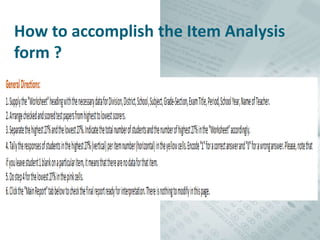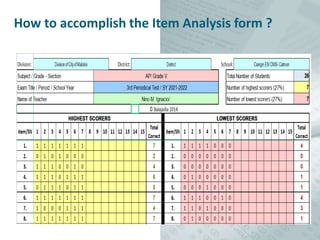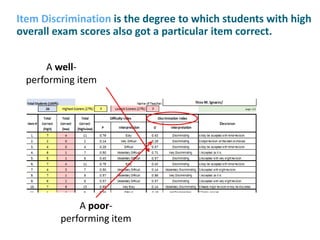Item_Analysis.pptx
- 1. Item Analysis JANE Q. IGNACIO
- 2. Why do we give tests / assessments? To find out if students learned what we intended To separate those who learned from those who didnĄŊt To increase learning and motivation To gather information for adapting or improving instruction
- 3. What is Item Analysis? It is the process of looking at the iutem respopnses of a test. The process used to judge the quality of an item. -Neeraja A process which examines student responses to individual test items (questions) in order to assess the quality of those items and of the test as a whole. -Washington.Edu
- 4. What are the purpose of conducting Item Analysis? To revise items which will be used again in later tests. To identify if the test item difficulty level is appropriate. To eliminate misleading items in a test. To increase the efficacy of your exams by testing knowledge accurately. To assess and improve the reliability of your tests
- 5. How to accomplish the Item Analysis form ?
- 6. How to accomplish the Item Analysis form ?
- 7. How to interpret the Item Analysis result ?
- 8. How to interpret the Item Analysis result ?
- 9. An item analysis focuses on 4 major pieces of information provided in the test score report. Test Score Reliability Item Difficulty Item Discrimination Decision
- 10. Test score reliability is an index of the likelihood that scores would remain consistent over time if the same test was administered repeatedly to the same learners. Reliability coefficients range from .00 to 1.00. Ideal score reliabilities are >.80. Higher reliabilities = less measurement error.
- 11. Item Difficulty is the percentage of students who answered an item correctly. Easier items have higher item difficulty values. More difficult items have lower item difficulty values.
- 12. Number of alternatives for each item What is an ĄŪidealĄŊ item difficulty statistic depends on 2 factors. Your reason for asking the question
- 13. Sometimes we include very easy or very difficult items on purpose. Did I deliberately pose difficult items to challenge my studentsĄŊ thinking? Did I deliberately pose easy items to test basic information or to boost studentsĄŊ confidence?
- 14. Item Discrimination is the degree to which students with high overall exam scores also got a particular item correct. A well- performing item A poor- performing item
- 15. Decision can be used to determine which test item were effective and which ones were not.
- 16. Whether to retain, revise, or eliminate items depends on item difficulty, item discrimination, decision, and your instruction.
















